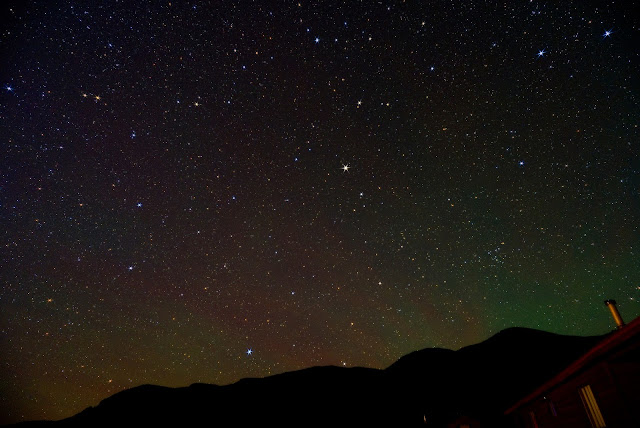When I checked the sky at 10pm on Tuesday night there were substantial clouds moving through the southern sky. An hour later the clouds were gone except for a few lingering dark patches in the north. The sky was dark, sqml=21.6, except for one problem: a neighbor on the hill to the south had a bright gable light burning. After some scouting around the property, I found a spot on the back driveway where the hay shed would block the direct line-of-sight to the offending light and still give me a view in the directions I wanted.
 |
| Sony A7iii + Sony FE 20mm f/1.8, Hoya Sparkle-6 filter. ISO 1600, 30 s. |
Many dedicated astrophotographers travel to exotic locations to get Milky-Way photos with alpine lakes and glaciers or African trees as foreground objects. And their photos are fantastic. I am not that dedicated, however, so what you get here is a photo with the hay shed, horse trailer, and Chevy truck as foreground.
 |
| As before. Vertical orientation. |
Looking west, Arcturus was descending toward Bristol Head. Arcturus is the fourth brightest star in the sky and the brightest in the North Celestial Hemisphere. Bristol Head is silhouetted against green and red airglow.
The primary objective of this photography session was to capture images of asteroid (249) Ilse (current magnitude 14.5) (and successful). For these I used a Rokinon 135mm f/2 lens and E-M5iii camera. Here are a couple images captured with the same setup:
 |
| The Coathanger cluster. ISO 1600, 60 s, Kase Astroblast filter. 5.5-deg FOV. |
 |
| Sadr, Gamma Cygni. |
Gamma Cygni, or Sadr, is the star at the center of the "Northern Cross" in the constellation Cygnus. In the image above, North is to the left. Sadr is a foreground star to the red nebulosity and not physically connected.
Here is a finder chart showing the location of this image:
 |
| Credit: SkySafariAstronomy.com |

No comments:
Post a Comment
Comments are moderated.